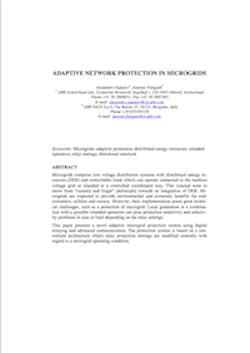Power systems currently undergo considerable change in operating requirements – mainly as a result of deregulation and due to an increasing amount of distributed energy resources (DER). In many cases DER include different technologies that allow generation in small scale (micro-sources) and some of them take advantage of renewable energy resources (RES) such as solar, wind or hydro energy. Having micro-sources close to the load has the advantage of reducing transmission losses as well as preventing network congestions. Moreover, the chance of having a power supply interruption of end-customers connected to a low voltage (LV) dis- tribution grid is diminished since adjacent micro-sources, controllable loads and energy storage systems can operate in the islanded mode in case of severe system disturbances on the transmission system level (in fact a power delivery can be fully independent of the state of the main grid). This is known today as a microgrid [1, 2] and is depicted in Figure 1 where the microgrid is connected to the main me- dium voltage (MV) grid when the circuit breaker 1 (CB1) is closed (the circuit breakers CB3.2 and 6.2 are normally open). Microgrids may potentially offer vari- ous advantages to end-consumers, utilities and society.
In light of these, the microgrid concept has stimulated many researchers and attracted the attention of governmental organizations in Europe, USA and Japan [3- 5]. Nevertheless, there are various technical issues associated with the integration and operation of microgrids. One of the major challenges is a network protection system for microgrid which must respond to both main grid and microgrid faults. In the first case the network protection system should isolate the microgrid from the main grid as rapidly as necessary to protect the microgrid loads. In the second case the protection system should isolate the smallest part of the microgrid when clears the fault [6]. A segmentation of microgrid, i.e. a creation of multiple islands or sumicrogrids must be supported by micro-source and load controllers. Under these circumstances, problems related to selectivity (false, unnecessary tripping) and sensitivity (undetected faults or delayed tripping) of protection system may arise.
